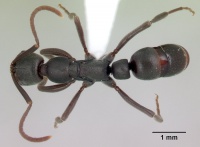Leptogenys fotsivava
| Leptogenys fotsivava | |
|---|---|

| |
| Scientific classification | |
| Kingdom: | Animalia |
| Phylum: | Arthropoda |
| Class: | Insecta |
| Order: | Hymenoptera |
| Family: | Formicidae |
| Subfamily: | Ponerinae |
| Tribe: | Ponerini |
| Genus: | Leptogenys |
| Species group: | truncatirostris |
| Species complex: | ridens |
| Species: | L. fotsivava |
| Binomial name | |
| Leptogenys fotsivava Rakotonirina & Fisher, 2014 | |
Leptogenys fotsivava has been found foraging on the surface of the ground and through leaf litter. Colony nests are known to be in soil layers and under rocks. Raiding behavior has been observed in the PN Isalo along a portion of the Sahanafa River.
Identification
A member of the ridens complex of the truncatirostris species group. Rakotonirina and Fisher (2014) - Worker. Clypeus with median carina, distance between anterior level of torulus and anteromedial clypeal margin greater than maximum width of scape; antennal scape relatively short; eye medium, maximum diameter between one-third and one-fourth the length of side of head; breaking outline of side of head; dorsum of mesosoma, petiolar node and gaster with few short suberect hairs and dense pubescence.
Keys including this Species
Distribution
Leptogenys fotsivava is distributed in natural dry forest habitats, gallery forests, and Uapaca woodlands in southern Madagascar, but also occurs in anthropogenic habitats.
Latitudinal Distribution Pattern
Latitudinal Range: -20.045° to -20.045°.
| North Temperate |
North Subtropical |
Tropical | South Subtropical |
South Temperate |
- Source: AntMaps
Distribution based on Regional Taxon Lists
Malagasy Region: Madagascar (type locality).
Distribution based on AntMaps
Distribution based on AntWeb specimens
Check data from AntWeb
Countries Occupied
| Number of countries occupied by this species based on AntWiki Regional Taxon Lists. In general, fewer countries occupied indicates a narrower range, while more countries indicates a more widespread species. |

|
Estimated Abundance
| Relative abundance based on number of AntMaps records per species (this species within the purple bar). Fewer records (to the left) indicates a less abundant/encountered species while more records (to the right) indicates more abundant/encountered species. |

|
Biology
|
Castes
Nomenclature
The following information is derived from Barry Bolton's Online Catalogue of the Ants of the World.
- fotsivava. Leptogenys fotsivava Rakotonirina & Fisher, 2014: 147, figs. 13B, 17A, 163, 172 (w.) MADAGASCAR.
Unless otherwise noted the text for the remainder of this section is reported from the publication that includes the original description.
Description
Worker
(8 specimens). HW: 0.98–1.17, HL: 1.18–1.33, CI: 82–90, SL: 1.15–1.39, SI: 112–119, PW: 0.72–0.84, WL: 1.91–2.15, PNH: 0.66–0.73, PNL: 0.53–0.57, PNW: 0.56–0.65, DNI: 106–115, LNI: 124–137.
Head longer than broad in full-face view, width weakly increasing from behind to front, sides generally straight anteriorly from posterior level of eyes and rounding into a more or less straight posterior margin. Eye medium, maximum diameter between one-third and one-fourth the length of side of head; small girth slightly breaking outline of sides of head. Antennal scape relatively short, about one-fourth of the length extending beyond posterior cephalic border. Median clypeal carina present; anteromedial clypeal margin rounded and covered with semi-translucent membranous spot. In full-face view, median lobe of clypeus relatively long, distance measured from anterior level of torulus to anteromedian clypeal margin greater than maximum diameter of scape. In full-face view, if mandible tightly closed against clypeus, basal two-thirds of blades touching anterior margin of clypeus while their apical third portions overlapping each other and extending downward in front of clypeus. With mesosoma in dorsal view, metanotal groove impressed, with faint cross-ribs. In lateral view, propodeal lobe absent. With petiole in dorsal view, node roughly as broad as long. Mandible longitudinally striate nearly to midlength; remaining portion smooth and shining apart from sparse punctures. Dorsum of head, mesosoma and petiolar node densely and finely reticulate-rugose to densely and finely reticulate-punctate. Third abdominal tergite densely and finely reticulate-punctate dorsally and mostly finely punctate laterally; fourth generally finely punctate. Pubescence numerous on entire dorsum of body, with sparse, suberect, short hairs. Color black to dark brown, with reddish-brown basal portion of appendages and light brown apices.
Type Material
Holotype worker: Madagascar, Toliara, Forêt de Kirindy, 15.5 km 64° ENE Marofandilia, -20.045, 44.6622, 100 m, tropical dry forest, ground nest, 28 Nov–3 Dec 2001 (Fisher-Griswold Arthropod Team) collection code: BLF04671, specimen code: CASENT0001423 (California Academy of Sciences). Paratypes: series of 6 workers with the same data as holotype but with the following specimen codes: CASENT0001421, CASENT00011422, CASENT0247211, CASENT0247212, CASENT0247213, CASENT0247214 (CASC, The Natural History Museum, Musee d'Histoire Naturelle Genève, Museum of Comparative Zoology, Parc Botanique et Zoologique de Tsimbazaza).
References
- Rakotonirina, J.C. & Fisher, B.L. 2014. Revision of the Malagasy ponerine ants of the genus Leptogenys Roger (Hymenoptera: Formicidae). Zootaxa 3836, 1-163.
References based on Global Ant Biodiversity Informatics
- Rakotonirina J. C., and B. L. Fisher. 2014. Revision of the Malagasy ponerine ants of the genus Leptogenys Roger (Hymenoptera: Formicidae). Zootaxa 3836 (1): 001163.


